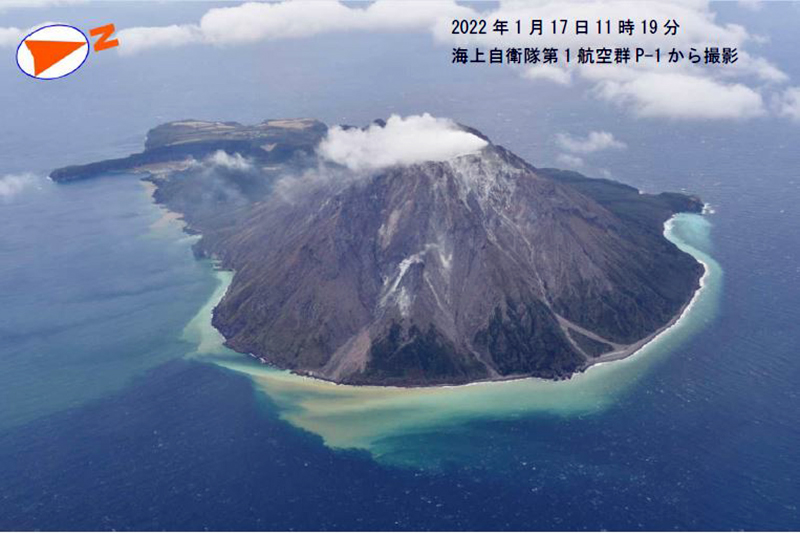Report on Kikai (Japan) — May 2023
Bulletin of the Global Volcanism Network, vol. 48, no. 5 (May 2023)
Managing Editor: Benjamin Andrews.
Edited by Kadie L. Bennis.
Kikai (Japan) Intermittent white gas-and-steam plumes, discolored water, and seismicity during May 2021-April 2023
Please cite this report as:
Global Volcanism Program, 2023. Report on Kikai (Japan) (Bennis, K.L., and Andrews, B., eds.). Bulletin of the Global Volcanism Network, 48:5. Smithsonian Institution.
Kikai
Japan
30.793°N, 130.305°E; summit elev. 704 m
All times are local (unless otherwise noted)
Kikai, located just S of the Ryukyu islands of Japan, contains a 19-km-wide mostly submarine caldera. The island of Satsuma Iwo Jima (also known as Satsuma-Iwo Jima and Tokara Iojima) is located at the NW caldera rim, as well as the island’s highest peak, Iodake. Its previous eruption period occurred on 6 October 2020 and was characterized by an explosion and thermal anomalies in the crater (BGVN 45:11). More recent activity has consisted of intermittent thermal activity and gas-and-steam plumes (BGVN 46:06). This report covers similar low-level activity including white gas-and-steam plumes, nighttime incandescence, seismicity, and discolored water during May 2021 through April 2023, using information from the Japan Meteorological Agency (JMA) and various satellite data. During this time, the Alert Level remained at a 2 (on a 5-level scale), according to JMA.
Activity was relatively low throughout the reporting period and has consisted of intermittent white gas-and-steam emissions that rose 200-1,400 m above the Iodake crater and nighttime incandescence was observed at the Iodake crater using a high-sensitivity surveillance camera. Each month, frequent volcanic earthquakes were detected, and sulfur dioxide masses were measured by the University of Tokyo Graduate School of Science, Kyoto University Disaster Prevention Research Institute, Mishima Village, and JMA (table 6).
Table 6. Summary of gas-and-steam plume heights, number of volcanic earthquakes detected, and amount of sulfur dioxide emissions in tons per day (t/d). Courtesy of JMA monthly reports.
| Month | Max plume height (m) | Volcanic earthquakes | Sulfur dioxide emissions (t/d) |
| May 2021 | 400 | 162 | 900-1,300 |
| Jun 2021 | 800 | 117 | 500 |
| Jul 2021 | 1,400 | 324 | 800-1,500 |
| Aug 2021 | 1,000 | 235 | 700-1,000 |
| Sep 2021 | 800 | 194 | 500-1,100 |
| Oct 2021 | 800 | 223 | 600-800 |
| Nov 2021 | 900 | 200 | 400-900 |
| Dec 2021 | 1,000 | 161 | 500-1,800 |
| Jan 2022 | 1,000 | 164 | 600-1,100 |
| Feb 2022 | 1,000 | 146 | 500-1,600 |
| Mar 2022 | 1,200 | 171 | 500-1,200 |
| Apr 2022 | 1,000 | 144 | 600-1,000 |
| May 2022 | 1,200 | 126 | 300-500 |
| Jun 2022 | 1,000 | 154 | 400 |
| Jul 2022 | 1,300 | 153 | 600-1,100 |
| Aug 2022 | 1,100 | 109 | 600-1,500 |
| Sep 2022 | 1,000 | 170 | 900 |
| Oct 2022 | 800 | 249 | 700-1,200 |
| Nov 2022 | 800 | 198 | 800-1,200 |
| Dec 2022 | 700 | 116 | 600-1,500 |
| Jan 2023 | 800 | 146 | 500-1,400 |
| Feb 2023 | 800 | 135 | 600-800 |
| Mar 2023 | 1,100 | 94 | 500-600 |
| Apr 2023 | 800 | 82 | 500-700 |
Sentinel-2 satellite images show weak thermal anomalies at the Iodake crater on clear weather days, accompanied by white gas-and-steam emissions and occasional discolored water (figure 24). On 17 January 2022 JMA conducted an aerial overflight in cooperation with the Japan Maritime Self-Defense Force’s 1st Air Group, which confirmed a white gas-and-steam plume rising from the Iodake crater (figure 25). They also observed plumes from fumaroles rising from around the crater and on the E, SW, and N slopes. In addition, discolored water was reported near the coast around Iodake, which JMA stated was likely related to volcanic activity (figure 25). Similarly, an overflight taken on 11 January 2023 showed white gas-and-steam emissions rising from the Iodake crater, as well as discolored water that spread E from the coast around the island. On 14 February 2023 white fumaroles and discolored water were also captured during an overflight (figure 26).
Geological Summary. Multiple eruption centers have exhibited recent activity at Kikai, a mostly submerged, 19-km-wide caldera near the northern end of the Ryukyu Islands south of Kyushu. It was the source of one of the world's largest Holocene eruptions about 6,300 years ago when rhyolitic pyroclastic flows traveled across the sea for a total distance of 100 km to southern Kyushu, and ashfall reached the northern Japanese island of Hokkaido. The eruption devastated southern and central Kyushu, which remained uninhabited for several centuries. Post-caldera eruptions formed Iodake (or Iwo-dake) lava dome and Inamuradake scoria cone, as well as submarine lava domes. Recorded eruptions have occurred at or near Satsuma-Iojima (also known as Tokara-Iojima), a small 3 x 6 km island forming part of the NW caldera rim. Showa-Iojima lava dome (also known as Iojima-Shinto), a small island 2 km E of Satsuma-Iojima, was formed during submarine eruptions in 1934 and 1935. Mild-to-moderate explosive eruptions have occurred during the past few decades from Iodake, a rhyolitic lava dome at the eastern end of Satsuma-Iojima.
Information Contacts: Japan Meteorological Agency (JMA), Otemachi, 1-3-4, Chiyoda-ku Tokyo 100-8122, Japan (URL: http://www.jma.go.jp/jma/indexe.html); Japan Coast Guard (JCG) Volcano Database, Hydrographic and Oceanographic Department, 3-1-1, Kasumigaseki, Chiyoda-ku, Tokyo 100-8932, Japan (URL: https://www1.kaiho.mlit.go.jp/kaiikiDB/kaiyo30-2.htm); Copernicus Browser, Copernicus Data Space Ecosystem, European Space Agency (URL: https://dataspace.copernicus.eu/browser/).




